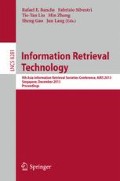Abstract
Search engine result pages – the ten blue links – are a staple of document retrieval services. The usual presumption is that users read these one-by-one from the top, making judgments about the usefulness of documents based on the snippets presented, accessing the underlying document when a snippet seems attractive, and then moving on to the next snippet. In this paper we re-examine this assumption, and present the results of a user experiment in which gaze-tracking is combined with click analysis. We conclude that in very general terms, users do indeed read from the top, but that at a detailed level there are complex behaviors evident, suggesting that a more sophisticated model of user interaction might be appropriate. In particular, we argue that users retain a number of snippets in an “active band” that shifts down the result page, and that reading and clicking activity tends to takes place within the band in a manner that is not strictly sequential.
Access this chapter
Tax calculation will be finalised at checkout
Purchases are for personal use only
Preview
Unable to display preview. Download preview PDF.
References
Aula, A., Majaranta, P., Räihä, K.-J.: Eye-tracking reveals the personal styles for search result evaluation. In: Costabile, M.F., Paternó, F. (eds.) INTERACT 2005. LNCS, vol. 3585, pp. 1058–1061. Springer, Heidelberg (2005)
Borlund, P.: Experimental components for the evaluation of interactive information retrieval systems. J. Documentation 56(1), 71–90 (2000)
Chapelle, O., Zhang, Y.: A dynamic Bayesian network click model for web search ranking. In: Proc. WWW, Madrid, Spain, pp. 1–10 (2009)
Dumais, S., Buscher, G., Cutrell, E.: Individual differences in gaze patterns for web search. In: Proc. IIiX, London, England, pp. 185–194 (2010)
Granka, L.A., Joachims, T., Gay, G.: Eye-tracking analysis of user behavior in WWW search. In: Proc. SIGIR, Sheffield, England, pp. 478–479 (2004)
Järvelin, K., Kekäläinen, J.: Cumulated gain-based evaluation of IR techniques. ACM Trans. Information Systems 20(4), 422–446 (2002)
Joachims, T., Granka, L., Pan, B., Hembrooke, H., Gay, G.: Accurately interpreting clickthrough data as implicit feedback. In: Proc. SIGIR, Salvador, Brazil, pp. 154–161 (2005)
Jones, T., Hawking, D., Thomas, P., Sankaranarayana, R.: Relative effect of spam and irrelevant documents on user interaction with search engines. In: Proc. CIKM, Glasgow, Scotland, pp. 2113–2116 (2011)
Kelly, D., Harper, D.J., Landau, B.: Questionnaire mode effects in interactive information retrieval experiments. Information Processing & Management 44(1), 122–141 (2008)
Moffat, A., Thomas, P., Scholer, F.: Users versus models: What observation tells us about effectiveness metrics. In: Proc. CIKM, San Francisco, California (to appear, 2013)
Moffat, A., Zobel, J.: Rank-biased precision for measurement of retrieval effectiveness. ACM Trans. Information Systems 27(1), 2:1–2:27 (2008)
Robertson, S.: A new interpretation of average precision. In: Proc. SIGIR, Singapore, pp. 689–690 (2008)
Smucker, M.D., Clarke, C.L.A.: Time-based calibration of effectiveness measures. In: Proc. SIGIR, Portland, Oregon, pp. 95–104 (2012)
Thomas, P., Scholer, F., Moffat, A.: Fading away: Dilution and user behaviour. In: Proc. 3rd Europ. Wrkshp. HCI and IR, Dublin, Ireland, pp. 3–6 (2013)
Voorhees, E.M.: Variations in relevance judgements and the measurement of retrieval effectiveness. Information Processing & Management 36(5), 697–716 (2000)
Wu, W.C., Kelly, D., Edwards, A., Arguello, J.: Grannies, tanning beds, tattoos and NASCAR: Evaluation of search tasks with varying levels of cognitive complexity. In: Proc. IIiX, Nijmegen, The Netherlands, pp. 254–257 (2012)
Yilmaz, E., Shokouhi, M., Craswell, N., Robertson, S.: Expected browsing utility for web search evaluation. In: Proc. CIKM, Toronto, Canada, pp. 1561–1564 (2010)
Author information
Authors and Affiliations
Editor information
Editors and Affiliations
Rights and permissions
Copyright information
© 2013 Springer-Verlag Berlin Heidelberg
About this paper
Cite this paper
Thomas, P., Scholer, F., Moffat, A. (2013). What Users Do: The Eyes Have It. In: Banchs, R.E., Silvestri, F., Liu, TY., Zhang, M., Gao, S., Lang, J. (eds) Information Retrieval Technology. AIRS 2013. Lecture Notes in Computer Science, vol 8281. Springer, Berlin, Heidelberg. https://doi.org/10.1007/978-3-642-45068-6_36
Download citation
DOI: https://doi.org/10.1007/978-3-642-45068-6_36
Publisher Name: Springer, Berlin, Heidelberg
Print ISBN: 978-3-642-45067-9
Online ISBN: 978-3-642-45068-6
eBook Packages: Computer ScienceComputer Science (R0)

